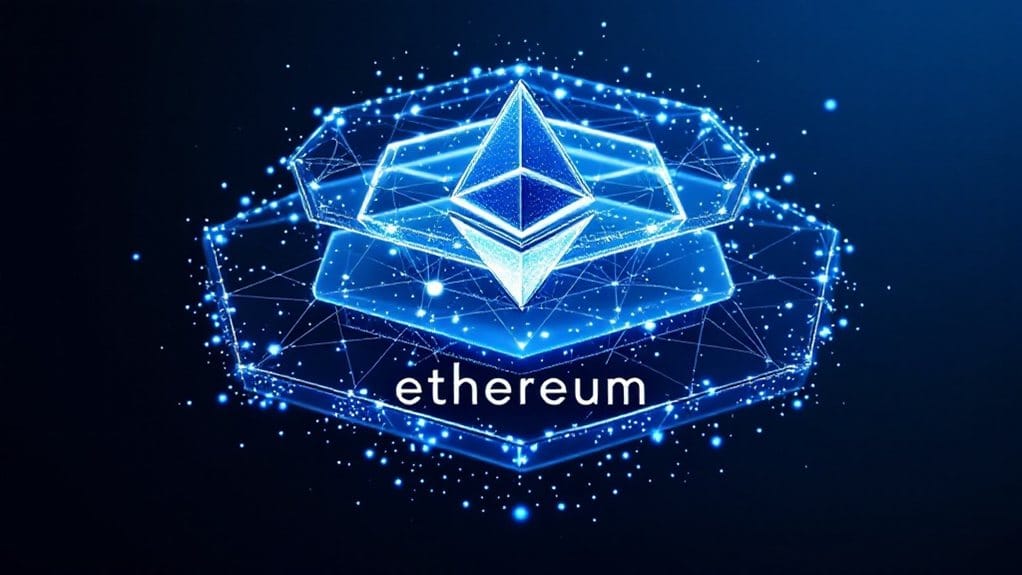Ethereum Layer-2 solutions process transactions off the main blockchain while maintaining security through diverse technological approaches, including rollups, state channels, and sidechains. These solutions dramatically boost Ethereum’s scalability by bundling multiple transactions into batches, reducing congestion and costs while increasing throughput from 15 to up to 7,000 transactions per interval in some implementations. The evolving Layer-2 ecosystem continues to reveal new possibilities for decentralized applications and services through improved efficiency and accessibility.

As blockchain technology continues to evolve, Ethereum Layer-2 solutions have emerged as vital innovations to address the scalability challenges inherent in the main Ethereum network. These solutions process transactions off-chain while maintaining the security and decentralization benefits of the Ethereum mainnet, effectively reducing network congestion and enabling higher transaction throughput.
Layer-2 solutions encompass diverse technological approaches, including rollups, state channels, sidechains, plasma chains, and validium implementations. Rollups, which have gained considerable traction, bundle multiple transactions into single batches before submitting them to the mainnet, dramatically reducing the data storage requirements and associated costs. The development of cross-layer interoperability standards will further enhance the connectivity between different Layer-2 solutions.
State channels establish direct payment corridors between participants, recording only the final settlement on the blockchain, while sidechains operate as independent chains that periodically synchronize with Ethereum. The fifteen transactions per second limitation of Ethereum’s mainnet has made Layer-2 solutions increasingly essential for network scalability.
The underlying mechanism of Layer-2 solutions involves processing transactions outside the main Ethereum network through sophisticated consensus mechanisms and smart contracts. These systems utilize decentralized networks of nodes or validators to guarantee transaction integrity, with periodic settlement processes that anchor the processed data back to the Ethereum mainnet, maintaining security while achieving superior scalability. Polygon, a prominent Layer-2 solution, utilizes a Proof-of-Stake model to process up to 7,000 transactions per second.
The implementation of Layer-2 solutions has delivered substantial benefits to the Ethereum ecosystem, particularly in reducing transaction costs and increasing processing speeds. Users can execute transactions at a fraction of the mainnet costs, while applications can achieve considerably higher throughput, enabling new use cases previously constrained by Layer-1 limitations.
The improved privacy features of certain Layer-2 implementations have also attracted users seeking more confidential transaction options.
Popular implementations like Arbitrum and Optimism have demonstrated the practical viability of Layer-2 solutions, processing millions of transactions while maintaining the security guarantees of the Ethereum network. These developments have proven essential for the broader adoption of blockchain technology, as they address the fundamental scalability limitations that previously hindered the growth of decentralized applications and services on the Ethereum platform.
FAQs
What Happens if a Layer-2 Solution Fails While Processing Transactions?
When a Layer-2 solution fails during transaction processing, several security mechanisms activate.
The system initiates transaction rollbacks to revert affected operations, while maintaining data integrity through records preserved on the main Ethereum network.
Failures remain contained within the Layer-2 environment, preventing disruption to the primary blockchain.
Furthermore, economic impacts may include temporary revenue declines and increased transaction costs until the issue resolves.
Can Layer-2 Solutions Be Used With Hardware Wallets?
Layer-2 solutions are fully compatible with hardware wallets like Ledger and Trezor through their existing Ethereum integration capabilities.
These wallets can securely store private keys while interacting with Layer-2 networks, requiring users to simply add the appropriate network settings.
Hardware wallets verify Layer-2 transactions directly, maintaining cold storage security while enabling access to scaling solutions like Arbitrum and Polygon through compatible interfaces.
How Do Layer-2 Solutions Handle Smart Contract Upgrades?
Layer-2 solutions manage smart contract upgrades through decentralized governance protocols and flexible rollup mechanisms.
These systems enable batch processing of transactions while maintaining compatibility with Ethereum’s main chain security features.
Smart contracts can be programmatically updated using frameworks like EIP-7002, which automates upgrade processes.
The technical complexity of upgrades is reduced through off-chain processing, while maintaining secure validation through the main chain.
Which Layer-2 Solution Has the Fastest Withdrawal Time to Mainnet?
Among Layer-2 solutions, zkSync and StarkNet, utilizing zero-knowledge proofs, offer the fastest withdrawal times to mainnet, typically completing in 10-15 minutes.
Optimistic rollups like Arbitrum and Optimism traditionally require longer waiting periods of 7 days, though recent innovations like Arbitrum’s Nitro upgrade and external bridging services have reduced these times to approximately 1-2 hours through advanced fraud-proof mechanisms.
Are Layer-2 Solutions More Vulnerable to Hacks Than Ethereum Mainnet?
Layer-2 solutions generally present more potential attack vectors than Ethereum mainnet due to additional trust assumptions and complexity in their infrastructure.
While L2s typically contain smaller amounts of locked value, making them less attractive targets, they introduce unique vulnerabilities through their reliance on operators, bridges, and smart contracts.
However, L2s benefit from inheriting Ethereum’s base layer security, and their risks can be effectively mitigated through proper security measures.









